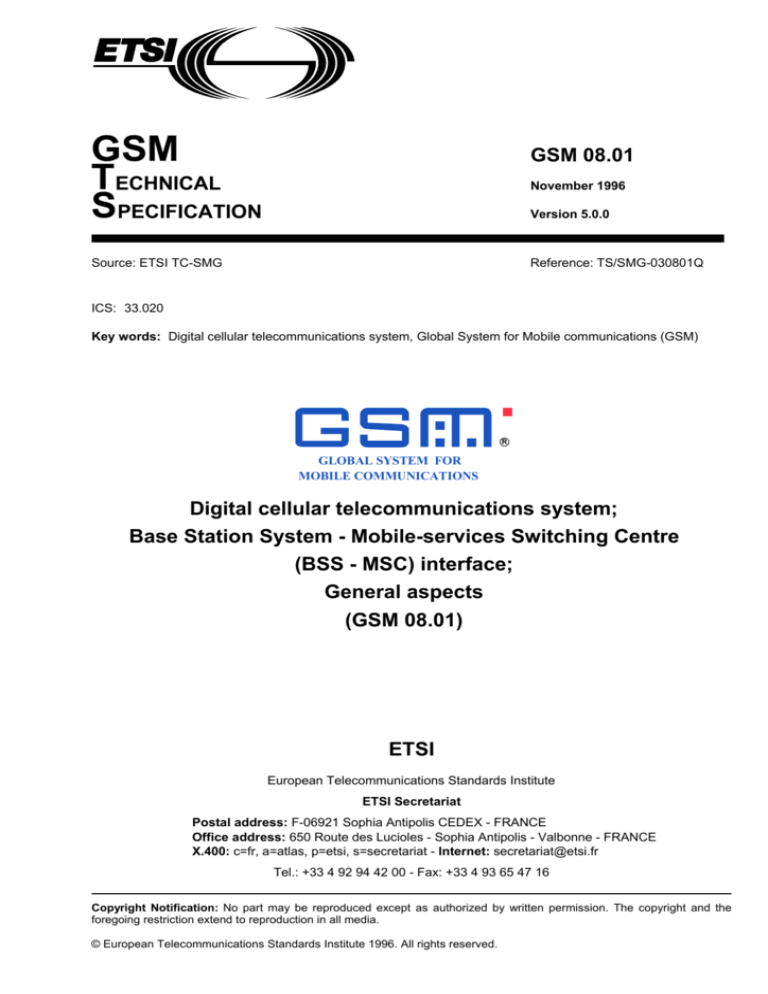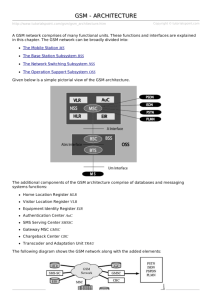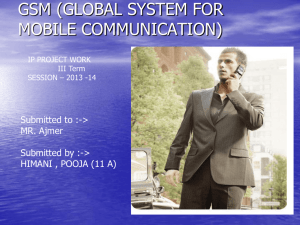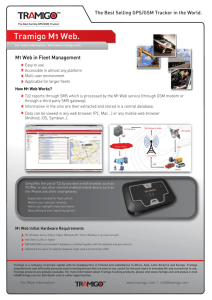
GSM
TECHNICAL
SPECIFICATION
GSM 08.01
November 1996
Version 5.0.0
Source: ETSI TC-SMG
Reference: TS/SMG-030801Q
ICS: 33.020
Key words: Digital cellular telecommunications system, Global System for Mobile communications (GSM)
R
GLOBAL SYSTEM FOR
MOBILE COMMUNICATIONS
Digital cellular telecommunications system;
Base Station System - Mobile-services Switching Centre
(BSS - MSC) interface;
General aspects
(GSM 08.01)
ETSI
European Telecommunications Standards Institute
ETSI Secretariat
Postal address: F-06921 Sophia Antipolis CEDEX - FRANCE
Office address: 650 Route des Lucioles - Sophia Antipolis - Valbonne - FRANCE
X.400: c=fr, a=atlas, p=etsi, s=secretariat - Internet: secretariat@etsi.fr
Tel.: +33 4 92 94 42 00 - Fax: +33 4 93 65 47 16
Copyright Notification: No part may be reproduced except as authorized by written permission. The copyright and the
foregoing restriction extend to reproduction in all media.
© European Telecommunications Standards Institute 1996. All rights reserved.
Page 2
GSM 08.01 Version 5.0.0: November 1996
Whilst every care has been taken in the preparation and publication of this document, errors in content,
typographical or otherwise, may occur. If you have comments concerning its accuracy, please write to
"ETSI Editing and Committee Support Dept." at the address shown on the title page.
Page 3
GSM 08.01 Version 5.0.0: November 1996
Contents
Foreword .......................................................................................................................................................5
0
Scope ..................................................................................................................................................7
0.1
Normative references ..........................................................................................................7
0.2
Abbreviations .......................................................................................................................7
1
A-Interface capabilities ........................................................................................................................7
2
A-Interface specification objectives.....................................................................................................8
3
A-Interface characteristics...................................................................................................................8
4
Other specifications on the MSC-BSS interface .................................................................................9
4.1
GSM 08.02 Interface Principles ...........................................................................................9
4.2
GSM 08.04 Layer 1 - Specification ......................................................................................9
4.3
GSM 08.06 Signalling Transport Mechanism - Specification...............................................9
4.4
GSM 08.08 Layer 3 Specification ........................................................................................9
4.5
GSM 08.20 Rate adaption on the BSS-MSC interface ......................................................10
History..........................................................................................................................................................11
Page 4
GSM 08.01 Version 5.0.0: November 1996
Blank page
Page 5
GSM 08.01 Version 5.0.0: November 1996
Foreword
This Global System for Mobile communications Technical Specification (GTS) has been produced by the
Special Mobile Group (SMG) Technical Committee (TC) of the European Telecommunications Standards
Institute (ETSI).
This GTS gives the general aspects Base Station System (BSS) to Mobile-services Switching Centre
(MSC) interface within the digital cellular telecommunications system
The contents of this GTS are subject to continuing work within TC-SMG and may change following formal
TC-SMG approval. Should TC-SMG modify the contents of this GTS it will then be republished by ETSI
with an identifying change of release date and an increase in version number as follows:
Version 5.x.y
where:
y
x
the third digit is incremented when editorial only changes have been incorporated in the
specification;
the second digit is incremented for all other types of changes, i.e. technical enhancements,
corrections, updates, etc.
The specification from which this GTS has been derived was originally based on CEPT documentation,
hence the presentation of this GTS may not be entirely in accordance with the ETSI rules.
Page 6
GSM 08.01 Version 5.0.0: November 1996
Blank page
Page 7
GSM 08.01 Version 5.0.0: November 1996
0
Scope
This Global System for Mobile communications Technical Specification (GTS) is an introduction to the
GSM 08.0X series of Technical Specifications and deals with the definition of the Base Station System
(BSS) to Mobile Switching Centre (MSC) (referred to as the A-interface) defined for the GSM system.
It also introduces Technical Specifications in the GSM 08.20 series, dealing with the support of data
services on this interface.
This GTS gives an overview of the content of the GSM 08.0X and GSM 08.20 series of Technical
Specifications explaining how the detailed content of the Technical Specifications is partitioned and how
the Technical Specifications can be used to support a full BSS-MSC interface.
0.1
Normative references
This GTS incorporates by dated and undated reference, provisions from other publications. These
normative references are cited at the appropriate places in the text and the publications are listed
hereafter. For dated references, subsequent amendments to or revisions of any of these publications
apply to this GTS only when incorporated in it by amendment or revision. For undated references, the
latest edition of the publication referred to applies.
[1]
GSM 01.04 (ETR 350): "Digital cellular telecommunications system (Phase 2+);
Abbreviations and acronyms".
[2]
CCITT Recommendation G.703:
hierarchical digital interfaces".
[3]
GSM 04.08 (ETS 300 940): "Digital cellular telecommunications
(Phase 2+); Mobile radio interface layer 3 specification".
[4]
GSM 04.21 (ETS 300 945): "Digital cellular telecommunications system; Rate
adaption on the Mobile Station - Base Station System (MS - BSS) interface".
[5]
GSM 08.02: "Digital cellular telecommunications system; Base Station System Mobile-services Switching Centre (BSS - MSC) interface; Interface principles".
[6]
GSM 08.04: "Digital cellular telecommunications system; Base Station System Mobile-services Switching Centre (BSS - MSC) interface; Layer 1 specification".
[7]
GSM 08.06: "Digital cellular telecommunications system; Signalling transport
mechanism specification for the Base Station System - Mobile-services
Switching Centre (BSS - MSC) interface".
[8]
GSM 08.08: "Digital cellular telecommunications system (Phase 2+); Mobile
Switching Centre - Base Station System (MSC - BSS) interface; Layer 3
specification".
[9]
GSM 08.20: "Digital cellular telecommunications system; Rate adaption on the
Base Station System - Mobile-services Switching Centre (BSS - MSC)
interface".
0.2
"Physical/electrical
characteristics
of
system
Abbreviations
Abbreviations used in this GTS are listed in GSM 01.04
1
A-Interface capabilities
The BSS-MSC interface shall be capable of supporting all the services offered to GSM users and
subscribers. In addition it also allows for the allocation of suitable radio resources within the PLMN, and
the operation and maintenance of those resources.
Page 8
GSM 08.01 Version 5.0.0: November 1996
2
A-Interface specification objectives
The MSC to BSS interface specifications shall allow the following:
i)
Connection of various manufacturers BSSs to the same MSC;
ii)
The use of several manufacturers MSCs to the same type of BSS;
iii)
The use of the same BSS in any PLMN;
iv)
The use of the same MSC in any PLMN;
v)
The separate evolution of MSC and BSS technology, and;
vi)
The separate evolution of O&M facilities;
vii)
Evolution towards lower speech coding rates;
viii)
Support of all services defined in the GSM 02 series of Technical Specifications.
3
A-Interface characteristics
The interface is defined to be at the boundary of the MSC.
The MSC to BSS interface is specified by a set of characteristics, including:
i)
Physical and electromagnetic parameters;
ii)
Channel structures;
iii)
Network operating procedures;
iv)
Operation and Maintenance information support.
The definition of the MSC to BSS interface follows a layered approach similar to that in the ISDN. Layer 3
is for the most part based on GSM 04.08 with additional procedures added for the control of radio
resources and the identification of transactions using the SCCP. Layer 2 is based on the signalling system
No.7 (SS No.7) Message Transfer Part (MTP). Layer 1 is either digital (at 2 048 kbit/s, based on CCITT
Recommendation G703 section 6) or analogue with the data being passed by the use of modems (this
latter case is a national option).
Page 9
GSM 08.01 Version 5.0.0: November 1996
4
Other specifications on the MSC-BSS interface
The full structure of the Technical Specifications specifying the MSC to BSS link are as follows:
4.1
GSM 08.02 Interface Principles
This Technical Specification deals with the functional split between the BSS and the MSC. This functional
split is then supported by the other Technical Specifications in the GSM 08.0X series.
GSM 08.02 also contains some information on the placement of transcoders/rate adapters, these being
functionally part of the BSS though a degree of freedom is allowed in their geographical location.
Lastly GSM 08.02 explains the use of transparent and non transparent signalling information across the
interface. The key point is that the majority of call related signalling from the MS is passed in a fairly
transparent way through the BSS.
4.2
GSM 08.04 Layer 1 - Specification
This Technical Specification defines the physical layer at the BSS-MSC interface point. The physical
interface chosen is a 2 Mbits/s (32*64 kbits/s) interface according to the standard CCITT
recommendations.
The speech coding called up in this Technical Specification is standard A-law, coding of the traffic bit
streams for data calls is dealt with in GSM 04.21 and GSM 08.20.
4.3
GSM 08.06 Signalling Transport Mechanism - Specification
In order to pass the signalling information between BSS and MSC some reliable transport mechanism has
to be used. The basis of the transport mechanism is an internationally agreed protocol known as signalling
system No.7.
Several services are required from this protocol but two key requirements are that messages can be
transferred between the BSS and MSC without corruption, and secondly that a transaction with a
particular mobile can be identified.
The correct transfer of messages without corruption is handled by the "Message Transfer Part" of SS
No.7 and this is documented in GSM 08.06 which is an exceptions document to the CCITT specification.
The subset so formed is designed so that it is compatible with a "full" MTP such as might be provided at
an MSC.
The identification of the transaction involved implies some form of logical connection. This is achieved by
using the signalling connection control part (SCCP) of SS No.7. Again a minimum subset is formed in
order to ease implementation.
4.4
GSM 08.08 Layer 3 Specification
In this Technical Specification the application parts are described. There are two currently identified in the
BSS to MSC interface protocol, these are the:
BSSOMAP;
BSSAP.
The BSSAP is further subdivided into two subprotocols, the BSSMAP and the DTAP.
The BSSMAP and DTAP are fully defined, the BSSOMAP is only supported in terms of a signalling
transport ability.
The DTAP text is split between GSM 08.06 and GSM 08.08 but the text in GSM 08.08 defines which
layer 3 air interface messages are passed transparently through the BSS and which are analysed at the
BSS.
Page 10
GSM 08.01 Version 5.0.0: November 1996
The BSSMAP (Base Station System Management Application Part) is that part of the protocol responsible
for all aspects of the radio resource handling at the BSS. The text is structured as a set of procedures
which are defined separately and can be employed as felt appropriate by the operator/manufacturer to
meet the requirements of the application in which it is being used. The procedures themselves can be
driven in different modes depending upon the input parameters received from the MSC or sent from the
OMC.
The BSSOMAP (Base Station System Operation and Maintenance Application Part) supports all of the
O and M communications for the BSS with either the MSC or the BSS. The actual detailed protocol at
layer 3 is defined in the 12-series of GSM Technical Specification.
4.5
GSM 08.20 Rate adaption on the BSS-MSC interface
This Technical Specification describes the means by which the radio interface data rates are adapted to
the 64 kbits/s needed at the MSC and vice versa, down to the bit level.
Page 11
GSM 08.01 Version 5.0.0: November 1996
History
Change history
SMG No.
TDoc.
No.
CR. No.
Section
affected
New
version
Subject/Comments
SMG#16
SMG#17
SMG#20
605/95
52/96
577/96
609/96
A003
A004r1
A005
A006
A.1.8
Table 2
D.2, D.2.5
6.1, Table 2
5.0.0
5.1.0
5.2.0
Data compression
Addition of handling for VBS and VCGS
Updating to account for EFR codec channels
General Bearer Services
Document history
November 1996
Publication of Version 5.0.0
ISBN 2-7437-1179-5
Dépôt légal : Novembre 1996







